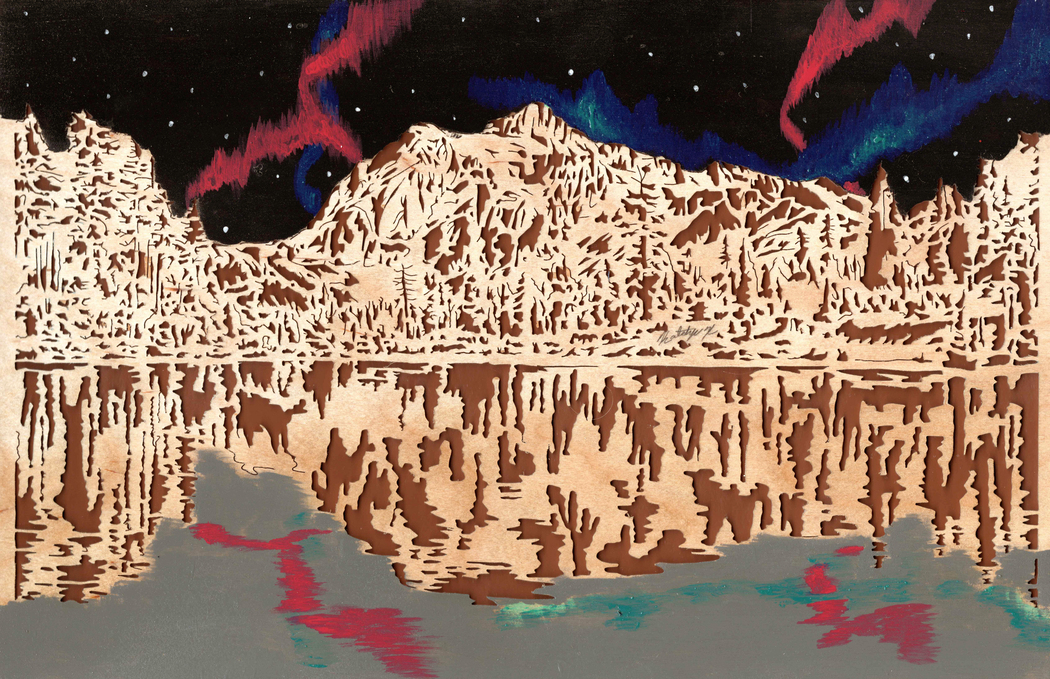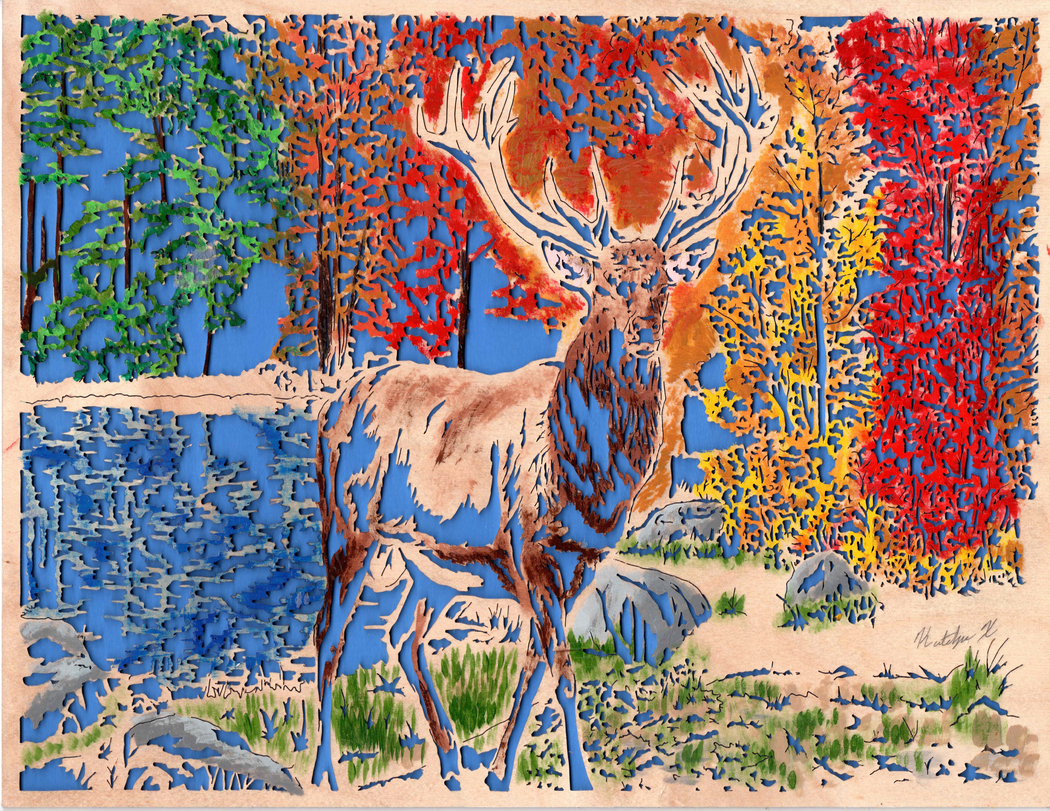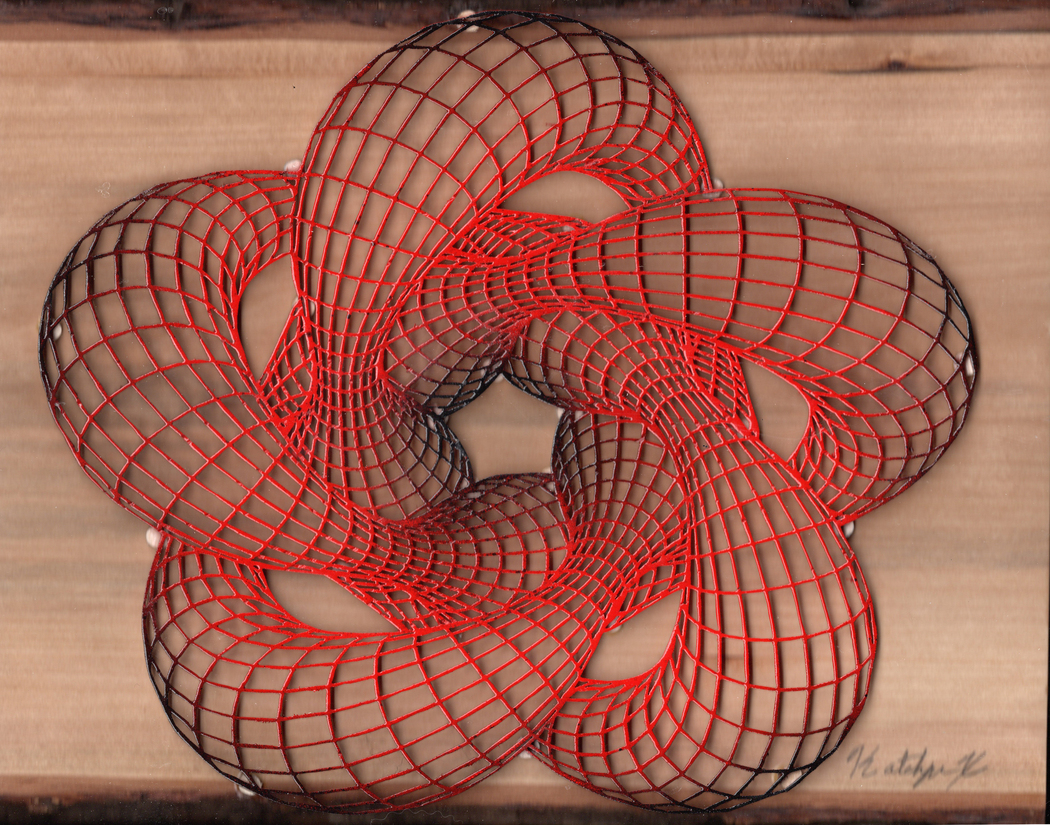Katelyn Dawson Exheres
I’m about to turn 38. Currently I live in Iowa and have for 20 years. I previously lived in Maryland and love the mountains and wild landscapes of Virginia. Mountain views or landscapes are a big draw if I can do something that replicates experiences from my childhood in my scroll work. I also love fall foliage and the northern lights even though I have yet to see the northern lights in person. I have a bachelor’s degree in liberal arts from Iowa State but for four years I was studying to be an architect. If I could describe my art in three words they would be: non-traditional, nature, unique.
Instagram
 Katelyn Dawson Exheres, CD Mountainscapt Painted Northernlights
Katelyn Dawson Exheres, CD Mountainscapt Painted Northernlights
What drew you to the art of scrollsawing, and what keeps you passionate about it?
I always had an interest in working with my hands. I loved art growing up but there were certain aspects of it that I never really felt proficient like freehand drawing. Same with doing woodworking; I loved building stuff or making things but I really didn’t like building for the sake of function. The scrollsaw was unique in that it could marry two interests, woodworking and art. What really got things started was when a former friend gave me a book on scrollsaw. I read it, saw a design, and adapted it for my own personal interests and did the project. Prior to that I’d only used a scrollsaw once and it wasn’t even the correct way. I tried cutting a piece of construction plywood on the thinnest blade on a scrollsaw. Amusing to consider now how foolish I was.
How has your style or approach to scrollsaw art evolved since you started in 2010?
When i first started, I was very much project oriented. I did projects to say I did them and completed them. I also called myself a crafts person as I didn’t really consider what I did as art. The projects were small and ornamental in nature. As time progressed I started working on wooden jewelry, charms for pendants, bracelets, and earrings. This phase was unique because while I still didn’t consider myself a true artist, I learned how to cut small and do fine details. This acquired skill is what has made my ability to cut intricate fretwork possible. It has been in the last two years that my style and approach has changed the most. I am now looking at my scroll work as a part of art and not just a ‘finished project’. Being done cutting doesn’t mean the piece is done. Now, against a lot of the more traditional minded scrollers, I’m adding paint or even exploring non-traditional subject matters to use in my art.
 Katelyn Dawson Exheres, Gandalf
Katelyn Dawson Exheres, Gandalf
Can you describe your creative process when working on a new piece? How do you choose your designs?
So choosing a design is important to me. I am to the point where I want to stand apart from other scrollers. Traditional scrollsaw art is very design based. It has also been derided by some as not true art because these designs are often sold to others and can be used to create the same piece. Enter the reason I want to stand apart. If a design or a concept has been designed and cut by hundreds of other scrollers, how does one stand apart? Answer: by the non-Traditional scrollsaw approach of adding color to the finished product. Another way would be by choosing designs no one else would view as scrollsaw worthy like a maze. Rather then cutting a piece and apply a black backer like everyone else, I want to tell a story. I want to take the piece and find a unique and previously untold story with my work. Sometimes that’s adding alot of paint or a little. Sometimes that’s using fairy lights to light up the project from behind. Sometimes it is mixing spray paint to create truly unique finishes. The key is let the piece tell me how it needs to be finished. Sometimes I know what the end will be when I start cutting. Sometimes it takes 2 weeks after I’m done before inspiration hits. The key is not to rush but let the art unfold in the way it needs to be told.
What challenges have you faced as a scrollsaw artist, and how have you overcome them?
There are really two primary challenge into scrollsaw art, external recognition that scrollsaw art is actually art and internal push back from other scrollers that painting or other ideas are not good approaches. The internal push back is actually the easiest for me to overcome. As a woman under the age of 40, I’m already an outlier in scrolling circles. Most scrollers are older and/or retired men. They approach the scrollsaw much like others have: this is the way to do things so let’s do it this way. As I previously said, I want to stand out and be viewed as an artist which means rejecting this mindset of traditional approaches and designs comes easily to me. Rather than viewing the project’s outcome as it’s final form, I am constantly looking at ways to tell a story and often times that story isn’t complete upon the end of cutting. So the saw is more becoming an avenue that I travel down to reach the finished art piece. But often that is but one avenue that I go down to do my art, a crucial one as it makes my art unique to me, but still not the only way. This is what sets me apart from my peers which has not always been greeted with warm regards to what I’m doing. As for the external, that is a more recent hurdle for me to overcome. Most people, the percentage seemingly as high as 9 out of 10, don’t know what a scrollsaw is. My work gets mistaken as lazer cut or CnC routinely so explaining it is routine. Then when people here premade designs are in play, their reaction is: not art. The reaction is quick, without looking closely at what I’ve done. I’m painting my projects. I’m scanning them into a digital format. I’m starting to use digital means to manipulate or combine pieces cut on the saw thru Photoshop to create new purely digital art. But while this is what I’m doing, being recognized as art is a struggle I’m facing. Being misidentified as something else or overlooked as a gimmick is a an ongoing struggle that until better information is accepted by the public will be an ongoing battle for me.
 Katelyn Dawson Exheres, CD Deerwoods Painted
Katelyn Dawson Exheres, CD Deerwoods Painted
Can you tell us how you balance working on smaller projects versus larger ones?
So from 2017-2019, I ran a small crafts vendor business with my then partner. The focus was on wooden jewelry. While doing small intricate designs helped my skills improve it wasn’t very rewarding. Actually it was quite the opposite. I went to arts and craft show and there were times where if I sold an item it was a good show. It was hard to compete with the manufactured cheap jewelry with the stuff I can make on my scrollsaw. I would love to say I had better stuff, better jewelry then my competitors. Unfortunately what I can say is my stuff took time to make and were priced higher. This being my second foray into a vendor business my focus is trying to build something where there is no true competition in my local market. To do this, my focus has been on large scale projects for the wow factor. I can set up amazingly cut pieces for display to catch people’s eye and draw them in. As my portfolio of these large projects has grown, I have been able to step back from the need to create things like this and focus on what I view as more fun and rewarding things but will not be the eye-catcher a 70 hour project is. It’s a balance at this point, to wow people but also to show the variety and range that is capable with a scrollsaw. Is it going to be successful long-term is an unknown but it’s generating interest and that’s how I want to get started with interest rather than being overlooked due to over-saturation in the market.
How do you approach size differences in your projects?
Honestly this is a hard one to answer as I’m restarting things again. My personal belief is that the larger projects will generate interest but it’ll be the small scale stuff that will determine long-term success. An average person isn’t going to be able to afford a $300-700+ large scale art piece from me. So while not revolutionary to the art world, I’m stepping into doing art prints of my pieces by scanning into my computer. My personal preference though is working on larger projects. I find them more rewarding and satisfying upon completion.
Can you describe what it’s like to run an Etsy shop?
Running an Etsy shop is a challenge. Your dealing with trying to find the right items to sell to people and trying to advertise your items. The downside, at least in my experience, is the stuff that I have been able to sell on Etsy is more manufactured items or I guess stuff that I can easily recreate. It’s kind of disappointing because it takes focus away from creating true art or one of a kind pieces and places my focus on trying to find stuff that sells in high volume. Personally I don’t like that.
 Katelyn Dawson Exheres, Built for speed
Katelyn Dawson Exheres, Built for speed
How would you describe your experience connecting with your audience on social media?
Ok so this is an interesting question. I actually don’t like doing social media. I’d prefer to cut or paint. However I realized in the modern world, the best way to be successful is by social media and building a web presence. It’s not easy personally. I don’t like being in front of crowds so doing videos are hard. I’m also very much a perfectionist so every one video I make I usually have 8+ attempts that I dislike and discarded. But stepping aside from my personal perspective, social media is something that isn’t utilized much by other scrollers. Most of the other scrollers are older so technology isn’t a go to. Plus a scrollsaw isn’t cutting edge technology so it caters to either older or a more niche group that cut. The reality is, for scroll work to survive, approaches to advertising or demonstrating it needs to change and the best way now is thru social media whether i like ot or not. Adaptation is the way to survive.
What advice would you give to someone interested in starting with scrollsaw art?
Be unique. Don’t follow in other people’s footsteps. Avoid certain ‘trap designs’ as it were. (Trap designs being something that looks like it should be popular like religious or patriotic themes only to have that already flooded by designs). Think outside convention and don’t be afraid to experiment with what you cut on the saw. Also if you create your own designs (highly recommended) don’t sell them. Protect your work and legacy as the only one that did something.
 Katelyn Dawson Exheres, Red fiveknot
Katelyn Dawson Exheres, Red fiveknot

Leave a Reply
You must be logged in to post a comment.